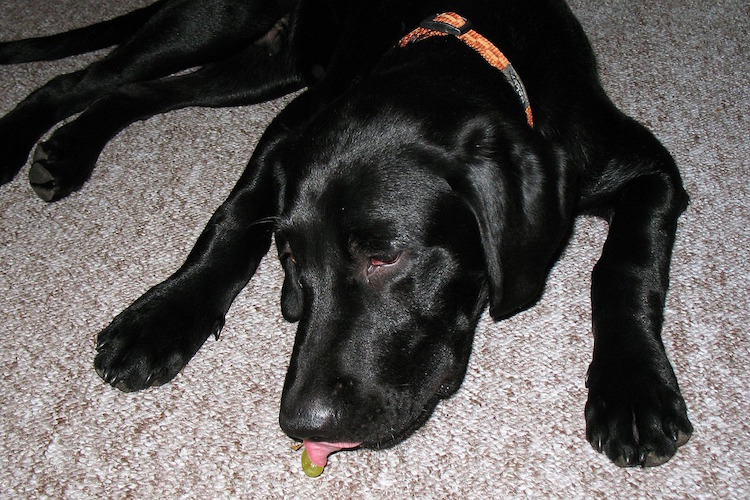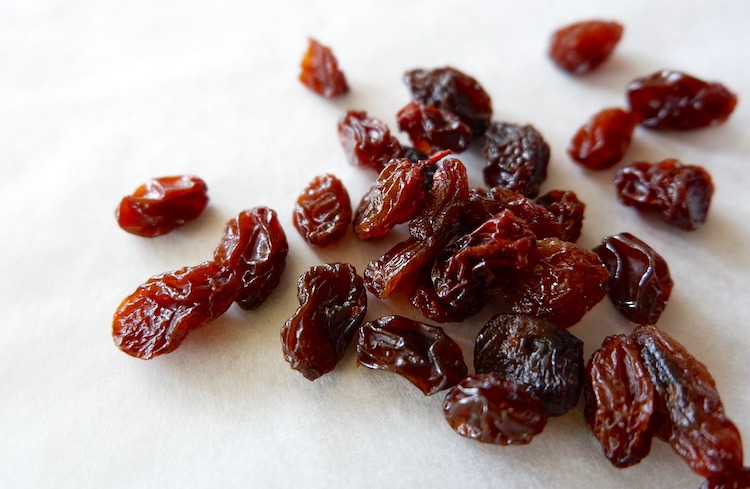
This pet health content was reviewed for accuracy by a veterinarian, Dr. Pippa Elliott, BVMS, MRCVS. This article was originally published in 2012 and is regularly updated. It was last reviewed for accuracy and updated on June 11, 2024
If you have questions or concerns, call your vet, who is best equipped to ensure the health and well-being of your pet. This article is for informational purposes only and is not a substitute for professional medical advice, diagnosis, or treatment. See additional information.

- My Dog Ate a Grape: Understanding Grape Toxicity in Dogs
- Are Grapes Toxic to Dogs?
- Why Dogs Shouldn’t Eat Grapes: Understanding the Risks
- How Toxic Are Grapes for Dogs?
- Symptoms of Grape Toxicity in a Dog
- Treatment of Grape Toxicity in a Dog
- Preventing Grape Toxicity in a Dog
- Frequently Asked Questions (FAQ)
- References
My Dog Ate a Grape: Understanding Grape Toxicity in Dogs
You may be wondering, “Can dogs eat grapes?”
Great question. A number of foods are toxic to pets, including grapes and chocolate. When it comes to grape toxicity, it’s crucial to know how much is safe for your pet. Keep reading, and we’ll explain everything we know about grape toxicity in dogs, ensuring you have the information needed to keep your furry friend safe.
If you’re concerned and thinking, “My dog ate a grape,” it’s important to act quickly. For more information on other toxic foods, check out our article on how much chocolate is toxic to dogs.
Are Grapes Toxic to Dogs?
- Yes, both grapes and raisins are toxic to dogs.
- The type of grape doesn’t matter:
- Green or red
- Commercially grown or from your backyard
- The source of the toxicity is unknown, but here’s what we know:
- Dogs have become ill and died from ingesting grapes and raisins (dried grapes).
If you have any further blocks of content to refine, please share them.
Why Dogs Shouldn’t Eat Grapes: Understanding the Risks
Consider the story of Rio:
- Incident: Rio’s owner, Angela, found him sick after he ate grapes left out in the kitchen.
- Immediate Action: Angela rushed Rio to the veterinarian.
- The vet flushed Rio’s system and worked on absorbing the toxin.
- Outcome: Rio was under 24-hour care for almost a week and required additional treatment at home. He suffered kidney damage but survived. Not all dogs are this lucky.
Experts are still unsure about the exact toxic component in grapes. Several substances, like herbicides and pesticides, have been examined, but the exact component remains a mystery. Grape seed extract is not listed as a threat. According to veterinary criticalist Dr. Nathan Lippo, DVM, DACVECC, any amount of grapes can be toxic to a dog. “The toxin in the fruit is unknown, but we do know it’s in the flesh of the grape — not the seeds, not the skin…. It affects them pretty badly,” says Dr. Lippo.
Toxicity from grapes and raisins can lead to kidney failure. Treatment depends on the amount of fruit ingested and how the dog’s body reacts to the toxin.

How Toxic Are Grapes for Dogs?
According to Small Animal Toxicology, there is a way to get a rough estimate of the toxic amount of grapes or raisins for a dog.
How Many Grapes Are Toxic to a Dog?
A general rule of thumb for when dangerous doses may begin:
- 1 or 2 grapes for a 10-pound dog
- 3 or 4 grapes for a 20-pound or heavier dog
How Many Raisins Are Toxic to a Dog?
A general rule of thumb for when dangerous doses may begin:
- 0.7 ounces for a 10-pound dog
- 1.4 ounces for a 20-pound dog
- 2.1 ounces for a 30-pound dog
- 2.8 ounces for a 40-pound or heavier dog
Raisins are more concentrated, so it takes fewer of them to cause problems. However, the amount of grapes or raisins eaten may not always determine the extent of harm caused to your pet.
- A report on Grape and Raisin Toxicity in Dogs (2007) discusses how a Border Collie ate a whole 16-ounce box of raisins and lived, yet a Labrador Retriever (a larger dog) died after eating a slightly larger box of raisins.
- As the Merck Veterinary Manual states, “A clear dose-response relationship has not been determined, but as few as 4–5 grapes were implicated in the death of an 18-lb (8.2-kg) dog.”
Take-Home Message:
If you’re concerned and thinking, “My dog ate a grape, maybe it’s fine?” please know that ANY amount of grapes or raisins should be considered toxic to dogs.

Symptoms of Grape Toxicity in a Dog
A variety of symptoms are possible with grape toxicity in a dog, including:
- Vomiting and/or diarrhea
- Hyperactivity
- Depression
- Lethargy
- Abdominal pain
- Fluid cessation (will not drink water or urinate)
- Loss of appetite
- Tremors
- Dehydration
- Breathing difficulty
- Kidney failure
- Death (depending on the amount consumed)
Yes, grapes can kill a dog. The body has to process and absorb the grapes, so death is not instantaneous—but time is important. The sooner treatment begins, the higher the chances of recovery for your dog.
Treatment of Grape Toxicity in a Dog
What happens when a dog eats grapes? Grape or raisin ingestion should be considered an emergency, and treatment should begin immediately:
- Immediate Response: If ingestion was within 2 hours, vomiting is usually induced by the veterinary staff, and activated charcoal administered.
- Intravenous Fluids: May be given for 48 hours to help flush out toxins.
- Monitoring: Blood chemistry panels are checked for 72 hours to monitor kidney function.
- Additional Diagnostics:
- Urinalysis to check for kidney damage.
- Ultrasound to examine kidney size and look for mineral deposits.
- Medications: Kidney medications may be prescribed based on the severity of the toxicity.
It’s important to see the vet even if the dog isn’t showing symptoms. The kidney damage can be delayed, but the sooner it is identified, the better for the dog. If you’re worried because “my dog ate a grape,” seeking immediate veterinary care is crucial.
Preventing Grape Toxicity in a Dog
Grape toxicity in pets was recognized years ago when a pattern was found in reports of sick dogs. A common factor was the ingestion of grapes or raisins, and veterinary professionals and pet lovers alike have been trying to spread the word since its discovery.
To prevent grape toxicity in dogs:
- Avoid Leaving Grapes or Raisins Out: Keep them off counters or in open pantries where your dog might be able to reach them.
- Secure Storage: Store grapes and raisins in sealed containers out of your pet’s reach.
- Educate Family and Friends: Ensure everyone in your household knows about the dangers of grapes and raisins to dogs.
Remember, the same precautions apply to cats—yes, grapes and raisins are toxic to cats as well.
By taking these steps, you can help prevent grape toxicity and keep your pets safe. If you’re ever in doubt, “My dog ate a grape” should prompt an immediate call to your veterinarian.
Frequently Asked Questions (FAQ)
My dog ate a grape, what should I do?
If your dog ate a grape, seek immediate veterinary care as grapes are highly toxic to dogs.
What if my dog ate a grape?
If your dog ate a grape, contact your veterinarian right away to prevent potential kidney failure.
What happens if my dog ate a grape?
If your dog ate a grape, it can lead to severe toxicity, so urgent veterinary attention is necessary.
References
- Campbell, Alexander, BSc. “Grapes, raisins and sultanas, and other foods toxic to dogs.” UK Vet Companion Animal. January 2007. https://onlinelibrary.wiley.com/doi/abs/10.1111/j.2044-3862.2007.tb00121.x.
- Alexander, Terry. “Six Deadly Foods for Dogs.” NBC 12 News. Feb. 15, 2011. http://www.nbc12.com/story/14029753/six-deadly-foods-for-dogs/.
- Peterson, Michael E., DVM, and Patricia A. Talcott, MS, DVM, PhD, DABVT. Small Animal Toxicology. Elsevier Health Sciences. 2013.
- Savigny, Michelle, DVM, and Douglass K. Macintire, DVM, DACVIM, DACVECC. “Grape and Raisin Toxicity in Dogs.” Department of Clinical Sciences College of Veterinary Medicine, Auburn University. 2007.
- Eubig, Paul A. et al. “Acute Renal Failure in Dogs After the Ingestion of Grapes or Raisins: A Retrospective Evaluation of 43 Dogs (1992–2002).” J Vet Intern Med 19 (2005): 663–74. https://onlinelibrary.wiley.com/doi/pdf/10.1111/j.1939-1676.2005.tb02744.x.
- Banfield Health Hospital. “Grapes and Raisins Can Be Toxic to Your Pets.” https://www.banfield.com/pet-healthcare/additional-resources/article-library/safety-tips/grapes-and-raisins-can-be-toxic-to-your-pets.


